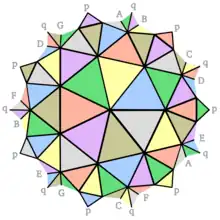Distance-regular graph
In the mathematical field of graph theory, a distance-regular graph is a regular graph such that for any two vertices v and w, the number of vertices at distance j from v and at distance k from w depends only upon j, k, and the distance between v and w.
Some authors exclude the complete graphs and disconnected graphs from this definition.
Every distance-transitive graph is distance-regular. Indeed, distance-regular graphs were introduced as a combinatorial generalization of distance-transitive graphs, having the numerical regularity properties of the latter without necessarily having a large automorphism group.
Intersection arrays
It turns out that a graph of diameter is distance-regular if and only if there is an array of integers such that for all , gives the number of neighbours of at distance from and gives the number of neighbours of at distance from for any pair of vertices and at distance on . The array of integers characterizing a distance-regular graph is known as its intersection array.
Cospectral distance-regular graphs
A pair of connected distance-regular graphs are cospectral if they have the same intersection array.
A distance-regular graph is disconnected if and only if it is a disjoint union of cospectral distance-regular graphs.
Properties
Suppose is a connected distance-regular graph of valency with intersection array . For all : let denote the -regular graph with adjacency matrix formed by relating pairs of vertices on at distance , and let denote the number of neighbours of at distance from for any pair of vertices and at distance on .
Graph-theoretic properties
- for all .
- and .
Spectral properties
- has distinct eigenvalues.
- if is a simple eigenvalue of
- for any eigenvalue multiplicity of unless is a complete multipartite graph.
- for any eigenvalue multiplicity of unless is a cycle graph or a complete multipartite graph.
If is strongly regular, then and .
Examples

Some first examples of distance-regular graphs include:
- The complete graphs.
- The cycles graphs.
- The odd graphs.
- The Moore graphs.
- The collinearity graph of a regular near polygon.
- The Wells graph and the Sylvester graph.
- Strongly regular graphs of diameter .
Classification of distance-regular graphs
There are only finitely many distinct connected distance-regular graphs of any given valency .[1]
Similarly, there are only finitely many distinct connected distance-regular graphs with any given eigenvalue multiplicity [2] (with the exception of the complete multipartite graphs).
Cubic distance-regular graphs
The cubic distance-regular graphs have been completely classified.
The 13 distinct cubic distance-regular graphs are K4 (or Tetrahedral graph), K3,3, the Petersen graph, the Cubical graph, the Heawood graph, the Pappus graph, the Coxeter graph, the Tutte–Coxeter graph, the Dodecahedral graph, the Desargues graph, Tutte 12-cage, the Biggs–Smith graph, and the Foster graph.
References
- Bang, S.; Dubickas, A.; Koolen, J. H.; Moulton, V. (2015-01-10). "There are only finitely many distance-regular graphs of fixed valency greater than two". Advances in Mathematics. 269 (Supplement C): 1–55. arXiv:0909.5253. doi:10.1016/j.aim.2014.09.025. S2CID 18869283.
- Godsil, C. D. (1988-12-01). "Bounding the diameter of distance-regular graphs". Combinatorica. 8 (4): 333–343. doi:10.1007/BF02189090. ISSN 0209-9683. S2CID 206813795.
Further reading
- Godsil, C. D. (1993). Algebraic Combinatorics. Chapman and Hall Mathematics Series. New York: Chapman and Hall. ISBN 978-0-412-04131-0. MR 1220704.